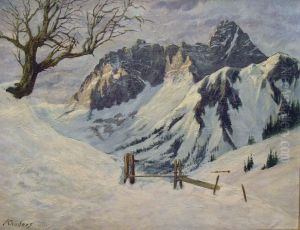Georg Manfred Kauders Paintings
Georg Manfred Kauders was an Austrian artist born in 1903 in Vienna. His life and career were profoundly affected by the turbulent political landscape of Europe during the first half of the 20th century, especially by the rise of the Nazi regime. Kauders, being of Jewish descent, found himself under increasing persecution during the 1930s as anti-Semitic laws and sentiment swept through Austria, particularly after the Anschluss of 1938 when Austria was annexed by Nazi Germany.
Despite these challenges, Kauders showed a passion and talent for art from an early age. He was part of a generation of artists who were searching for new means of expression in the wake of World War I. His work was influenced by various movements of the time, including Expressionism and Modernism. Kauders was known for his vibrant use of color and the emotional depth of his paintings. Unfortunately, due to the rise of the Nazi regime and its destructive policies, much of Kauders' early work was lost or destroyed, and his artistic output was severely stifled.
As the situation for Jews in Nazi-occupied Europe worsened, Kauders' circumstances became increasingly dire. In 1941, at the age of 38, Georg Manfred Kauders was deported to a concentration camp, where he perished. The exact details of his death are not well-documented, reflecting the tragic loss of countless lives during the Holocaust which often left little record of their individual stories.
His art, much like his life, was cut tragically short. The legacy of Georg Manfred Kauders is reflective of many artists of his time who were silenced by the Nazi regime. There has been a resurgence of interest in the works of these lost artists as historians and art enthusiasts seek to recover and honor their contributions to the world of art. Kauders' surviving works are a testament to his talent and serve as poignant reminders of the human cost of intolerance and hatred.
